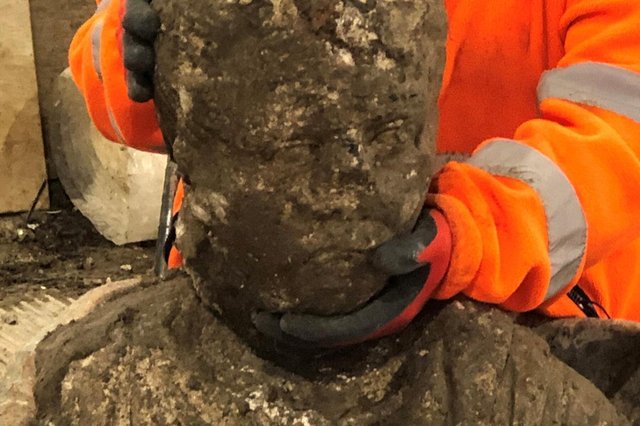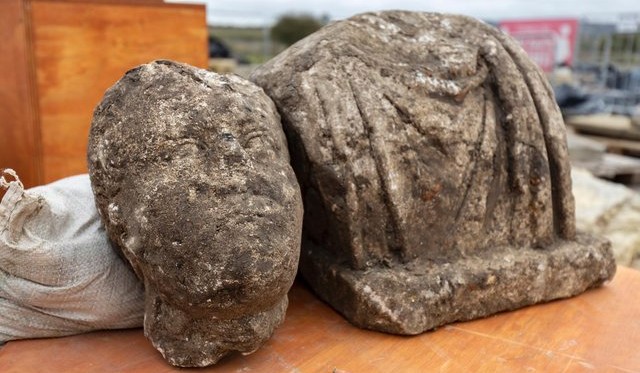Extremely rare Roman statues have been discovered during an excavation in Aylesbury, according to the Buckingham Advertiser.
It’s the latest unique historical discovery found by HS2 staff excavating a Norman Church in Stoke Mandeville.
Last month the same team of archaeologists found the remains of a church pre-dating the Norman era, historians labelled it ‘a once in a career’ discovery.
Workers were finishing their clear out job on the old St Mary’s Norman church in Stoke Mandeville when the discovery was made.
When digging around an area which is thought to be the foundations of an Anglo-Saxon tower, three stone busts which experts say are of a Roman design were found.
Two of the busts comprise of a head and torso which had been split before deposition, and the other just the head. The two complete statues appear to be one female adult and one male adult, with an additional head of a child.
The expert excavators have called the discovery, “uniquely remarkable for us as archaeologists”.

In addition to the statues, an incredibly well-preserved hexagonal glass Roman jug was also discovered.
Despite being in the ground for what is thought to be over 1,000 years, the glass jug had large pieces still intact. Archaeologists working at the site were able to remove what they believe to be almost all of the fragments.
The team can only find one comparison for this, a completely intact vessel which is currently on display in the Metropolitan Museum of Art, New York. Other finds include large roof tiles, painted wall plaster, and Roman cremation urns.
Fusion JV and its archaeological contactor, L-P Archaeology are carrying out the work which has led to these extremely rare finds.
Dr Rachel Wood, lead archaeologist for Fusion JV, said: “For us to end the dig with these utterly astounding finds is beyond exciting. The statues are exceptionally well preserved, and you really get an impression of the people they depict – literally looking into the faces of the past is a unique experience.
“Of course, it leads us to wonder what else might be buried beneath England’s medieval village churches. This has truly been a once in a lifetime site and we are all looking forward to hearing what more the specialists can tell us about these incredible statues and the history of the site before the construction of the Norman church.”
With the excavating work coming to an end in Stoke Mandeville, the experts on site have developed theories relating to their findings.
A HS2 spokesperson said: “The site appears to be a natural mound, which has then been deliberately covered with soil to create a taller mound. It is possible this may have formed a Bronze Age burial site. It appears this was then replaced by a square building which may have originated in the Roman period.
“Archaeologists now believe the square building that pre-dates the Norman church is a Roman mausoleum. Roman materials found in the ditch around are too ornate and not enough in number to suggest the site was a domestic building.
The Roman building appears to have been finally demolished by the Normans when building St Mary’s church, after possible reuse during the Saxon period.
“The walls and demolition rubble of the Roman building are directly beneath the Norman foundations with no soil build up in between. Saxon pottery was also found in a cut of the ditch, as well as a Saxon coin. Further analysis of the data is being undertaken and the team hope to confirm this hypothesis.”
The artefacts will now be taken to a specialist laboratory where they will be cleaned and examined, HS2 says.
Mike Court, lead archaeologist at HS2 said: “HS2’s unprecedented archaeology programme has given us new insights into Britain’s history, providing evidence of where and how our ancestors lived. These extraordinary Roman statues are just some of the incredible artefacts uncovered between London and the West Midlands. As HS2 builds for Britain’s future, we are uncovering and learning about the past, leaving a legacy of knowledge and discovery.”
An HS2 spokesperson provided further analysis on the Roman findings, adding: “The disfiguration of the Roman busts, namely the removal of the head of each, is not entirely unusual as it is common for statues such as these to have been vandalised in some way before being torn down.
“These are early examples of how statues and historic artefacts have been discarded as society has evolved over time.
“Roman statues were typically painted bright colours, so evidence of pigmentation in the creases of the statue will be examined. The final destination for the Roman finds will be determined in due course.”
Image Sources: The Buckingham Advertiser




